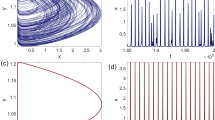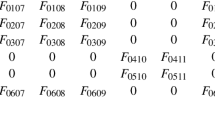Abstract
We derive a coarse-grained model that captures the temporal evolution of DNA nanotube length distribution during growth experiments. The model takes into account nucleation, polymerization, joining, and fragmentation processes in the nanotube population. The continuous length distribution is segmented, and the time evolution of the nanotube concentration in each length bin is modeled using ordinary differential equations. The binning choice determines the level of coarse graining. This model can handle time varying concentration of tiles, and we foresee that it will be useful to model dynamic behaviors in other types of biomolecular polymers.







Similar content being viewed by others
Notes
A bin size smaller than 0.3 \({\upmu }\)m is not advisable in our case due to the limited resolution of our microscope, which is roughly 0.1 \({\upmu }\)m per pixel. A length difference around 1 or 2 pixels is too uncertain to be trusted. (For this reason, nanotubes shorter than 0.3 \({\upmu }\)m were discarded in our image processing script.) This means that \(l_b=\)0.3 \({\upmu }\)m is the minimum bin size we can choose.
References
Andrews SS (2014) Methods for modeling cytoskeletal and DNA filaments. Phys Biol 11(1):011,001
Douglas SM, Chou JJ, Shih WM (2007) DNA-nanotube-induced alignment of membrane proteins for NMR structure determination. Proc Natl Acad Sci 104(16):6644–6648
Ekani-Nkodo A, Kumar A, Fygenson DK (2004) Joining and scission in the self-assembly of nanotubes from DNA tiles. Phys Rev Lett 93(26):268,301
Evans CG, Hariadi RF, Winfree E (2012) Direct atomic force microscopy observation of DNA tile crystal growth at the single-molecule level. J Am Chem Soc 134(25):10485–10492
Flyvbjerg H, Jobs E, Leibler S (1996) Kinetics of self-assembling microtubules: an “inverse problem” in biochemistry. Proc Natl Acad Sci 93(12):5975–5979
Fogler HS (2005) Elements of chemical reaction engineering, 4th edn. Prentice-Hall International, London
Gillam J, MacPhee C (2013) Modelling amyloid fibril formation kinetics: mechanisms of nucleation and growth. J Phys Condens Matter 25(37):373,101
Gutenkunst RN, Waterfall JJ, Casey FP, Brown KS, Myers CR, Sethna JP (2007) Universally sloppy parameter sensitivities in systems biology models. PLoS Comput Biol 3(10):e189
Hariadi RF, Winfree E, Yurke B (2015) Determining hydrodynamic forces in bursting bubbles using DNA nanotube mechanics. Proc Natl Acad Sci 112(45):E6086–E6095
Hariadi RF, Yurke B, Winfree E (2015) Thermodynamics and kinetics of DNA nanotube polymerization from single-filament measurements. Chem Sci 6(4):2252–2267
Knowles TP, Waudby CA, Devlin GL, Cohen SI, Aguzzi A, Vendruscolo M, Terentjev EM, Welland ME, Dobson CM (2009) An analytical solution to the kinetics of breakable filament assembly. Science 326(5959):1533–1537
Liu D, Park SH, Reif JH, LaBean TH (2004) DNA nanotubes self-assembled from triple-crossover tiles as templates for conductive nanowires. Proc Natl Acad Sci USA 101(3):717–722
Mardanlou V, Green LN, Subramanian HK, Hariadi RF, Kim J, Franco E (2016) A coarse-grained model of DNA nanotube population growth. In: International conference on DNA-based computers. Springer, pp 135–147
Markvoort AJ, Eikelder HMt, Hilbers PA, de Greef TF (2016) Fragmentation and coagulation in supramolecular (Co) polymerization kinetics. ACS Cent Sci 2(4):232–241
Mitchell JC, Harris JR, Malo J, Bath J, Turberfield AJ (2004) Self-assembly of chiral DNA nanotubes. J Am Chem Soc 126(50):16342–16343
Mohammed AM, Schulman R (2013) Directing self-assembly of DNA nanotubes using programmable seeds. Nano Lett 13(9):4006–4013
Reif JH, LaBean TH, Seeman NC (2000) Challenges and applications for self-assembled DNA nanostructures? In: International workshop on DNA-based computers. Springer, pp 173–198
Reif JH, Sahu S, Yin P (2006) Compact error-resilient computational DNA tilings. In: Chen J, Jonoska N, Rozenberg G (eds) Nanotechnology: science and computation. Springer, pp 79–103
Rothemund PWK, Ekani-Nkodo A, Papadakis N, Kumar A, Fygenson DK, Winfree E (2004) Design and characterization of programmable DNA nanotubes. J Am Chem Soc 126(50):16344–16352
Schulman R, Winfree E (2007) Synthesis of crystals with a programmable kinetic barrier to nucleation. Proc Natl Acad Sci 104(39):15236–15241
Sharma J, Chhabra R, Cheng A, Brownell J, Liu Y, Yan H (2009) Control of self-assembly of DNA tubules through integration of gold nanoparticles. Science 323(5910):112–116
Soloveichik D, Winfree E (2007) Complexity of self-assembled shapes. SIAM J Comput 36(6):1544–1569
Subsoontorn P, Kim J, Winfree E (2012) Ensemble Bayesian analysis of bistability in a synthetic transcriptional switch. ACS Synth Biol 1(8):299–316
Winfree E (1998) Simulations of computing by self-assembly. Technical Report, California Institute of Technology
Zhang DY, Hariadi RF, Choi HMT, Winfree E (2013) Integrating DNA strand-displacement circuitry with DNA tile self-assembly. Nat Commun 4:1965
Acknowledgements
The authors thank Deborah K. Fygenson, Bernard Yurke, Rebecca Schulman, and Martha Grover for advice and discussions. This research was entirely supported by DE Grant SC0010595.
Author information
Authors and Affiliations
Corresponding author
Appendix
Appendix
Table 2 reports the best performing parameter set when the model is modified to have a bin size \(l_b=0.6\, {\upmu }\hbox {m}\) (we are increasing the model coarse-grainedness). Figure 8 shows an overview of the model performance (training and validation).
Overview of model fitting and validation when the nanotube length distribution bin size is \(l_b=0.6\, {\upmu }\hbox {m}\), twice the nominal \(l_b\) adopted in this paper. For brevity we do not show individual fits and predictions of nanotube cumulative distributions, histograms, and tile/nuclei concentrations over time; these plots look qualitatively similar to those in Figs. 3, 4, and 5. a Mean nanotube length. b Predicted and measured nanotube density (number of nanotubes in a \(100 \times 100\, {\upmu }\hbox {m}\) area). (Color figure online)
Rights and permissions
About this article
Cite this article
Mardanlou, V., Yaghoubi, K.C., Green, L.N. et al. A coarse-grained model captures the temporal evolution of DNA nanotube length distributions. Nat Comput 17, 183–199 (2018). https://doi.org/10.1007/s11047-017-9657-7
Published:
Issue Date:
DOI: https://doi.org/10.1007/s11047-017-9657-7





